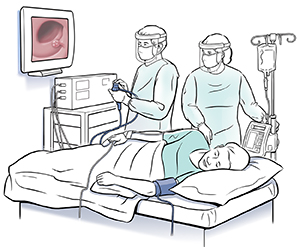Sigmoidoscopy
Sigmoidoscopy is a procedure used to look at the lower colon and rectum. This test can help find the source of belly pain or rectal bleeding. It can help find the reason for changes in bowel habits. It's used as part of the screening for colorectal cancer. It's done using a sigmoidoscope. This is a flexible, lighted tube. It has a small video camera on the end.
Screening
The American Cancer Society and the U.S. Preventive Services Task Force advise that you start having regular screening for colorectal cancer if you’re 45 or older and at average risk. A sigmoidoscopy is advised every 5 years. Your healthcare provider may also advise other colon cancer screening methods. These include colonoscopy. Talk with your provider about colorectal screening. You may need a colonoscopy as the next step if a sigmoidoscopy shows polyps.
Getting ready
To get ready for the test:
-
Tell your healthcare provider about any medicines, vitamins, and other supplements you take. Tell them about any health conditions you may have. Tell them if you've had a recent illness, such as an infection.
-
Ask your healthcare provider about the risks of the test. These include bleeding and bowel puncture.
-
Your rectum and colon must be empty for the test. Follow the diet and bowel prep directions. If you don't, the test may need to be rescheduled.
-
You will be asked to sign a consent form. Make sure all of your questions are answered before you sign.
During the test
Here is what to expect:
-
The test may be done in the healthcare provider’s office. It may be done in an outpatient surgery center or in a hospital. You may wear a gown or a drape over your lower body.
-
The procedure usually takes 10 to 20 minutes.
-
The healthcare provider does a finger (digital) rectal exam. This is to check for anal and rectal problems.
-
The rectum is lubricated. Then the scope is put in.
-
You may have a feeling like you need to have a bowel movement. You may feel pressure when air is pumped into the colon. This is done so that the healthcare provider can get a better view. It’s expected that you will pass gas during the procedure.
-
Small samples of tissue in the colon may be taken. This is called a biopsy.

After the test
Here is what to expect:
-
Your healthcare provider will likely talk with you about the results right away. This might not happen if you’re having other tests.
-
If a biopsy was done, ask when to call for the results.
-
Try to pass all the gas right after the test. If you don't, you may have bloating and cramping.
-
Slight bleeding from the rectum is normal. This can happen if a biopsy was done.
-
After the test you can go back to your normal eating and other activities.
When to call your healthcare provider
Call your healthcare provider right away if you have any of these :
© 2000-2025 The StayWell Company, LLC. All rights reserved. This information is not intended as a substitute for professional medical care. Always follow your healthcare professional's instructions.